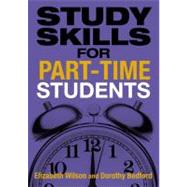- ISBN: 9780273719359 | 0273719351
- Cover: Paperback
- Copyright: 12/17/2009
| Studying: a life changing experience | |
| Earning and learning: examples of different patterns of work and study | |
| Where do you fit in? | |
| Conducting a personal skills analysis Auditing the support network: friends, family, professional colleagues, university Getting credit for prior experience (Credit transfer/APL/APEL) | |
| Learning as an adult How do we learn? | |
| Understanding learning styles Building on previous experience | |
| The workplace as a source of learning Barriers to learning: finding time and space to study Motivation techniques for further study Managing morale Learning from feedback Time management, meeting deadlines and managing tasks Stress management, dealing with unforeseen circumstances | |
| Strategies for supporting learning | |
| Using the Learning Resources Centre | |
| Reading effectively | |
| Making notes and effective summaries of texts | |
| Identifying key points from lectures | |
| Learning in tutorials, groups and seminars | |
| Looking at available support for improving basic skills | |
| Using technology to enhance your learning | |
| Internet and electronic resources | |
| The importance of anti-virus software and backups | |
| Learning online in the virtual classroom | |
| Podcasting and social media | |
| Studying at a distance: coping strategies for distance learning students | |
| Personal development planning: making the most of opportunities Producing a reflective journal Skills auditing and creating a personal development plan Using data from your workplace Compiling a professional development portfolio | |
| Data collection and presentation | |
| Why collect data? | |
| Gaining access to workplace data | |
| What the data can say | |
| Qualitative and quantitative analysis | |
| Presenting the findings | |
| Drawing conclusions from the data | |
| Effective writing techniques | |
| Writing for academic purposes and how this differs from workplace communication | |
| Expectations of undergraduate level writing | |
| Understanding marking criteria | |
| How to tackle your first written assignment | |
| Dealing with +writer's block' | |
| How to produce bibliographies, quotations and citations (and avoid plagiarism) | |
| Quotations in the text: which, how many and why? | |
| Referencing quotations and citations in the text | |
| What is plagiarism and how can it be avoided | |
| Footnotes and other techniques for presenting additional information | |
| Using the University approved system to compile a bibliography | |
| Creating indexes and contents electronically | |
| Essays, reports and dissertations | |
| Analysing what you have been asked to do: writing an assignment, essay, report or dissertation | |
| Different types of essays | |
| Understanding the task | |
| Structuring an argument | |
| Drawing conclusions | |
| Writing, revising and editing | |
| Table of Contents provided by Publisher. All Rights Reserved. |
The New copy of this book will include any supplemental materials advertised. Please check the title of the book to determine if it should include any access cards, study guides, lab manuals, CDs, etc.
The Used, Rental and eBook copies of this book are not guaranteed to include any supplemental materials. Typically, only the book itself is included. This is true even if the title states it includes any access cards, study guides, lab manuals, CDs, etc.
Digital License
You are licensing a digital product for a set duration. Durations are set forth in the product description, with "Lifetime" typically meaning five (5) years of online access and permanent download to a supported device. All licenses are non-transferable.
More details can be found here.






